What are bacterial skin infections?
Skin infections can be caused by bacteria (often Staphylococcal or Streptococcal) either invading normal skin, or affecting a compromised skin barrier (eg, skin affected by atopic dermatitis, or surgical wound sites).
The skin is our first line of protection against the environment. A local or systemic response is activated when this protective barrier is invaded. Microorganisms that invade the skin can be part of the external environment or the normal skin microbiome.
Honey-coloured crusts on the chin in impetigo
A swollen tender hot left leg due to Streptococcal cellulitis
Interdigital and toe pitted keratolysis
Ecthyma gangrenosum due to Pseudomonas septicaemia Palmar erythematous macules suggestive of secondary syphilis
Sporotrichoid spreading Mycobacterium marinum infection
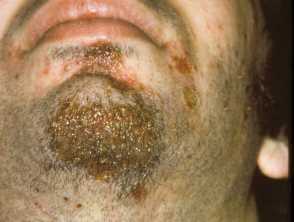
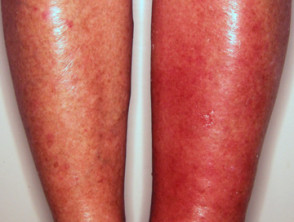

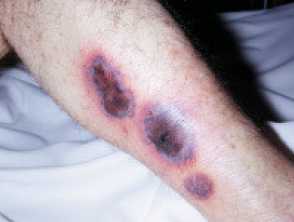
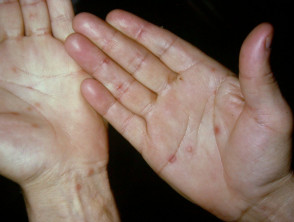
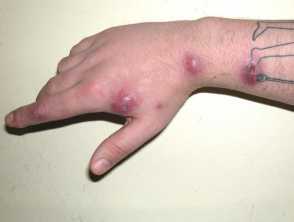
More images of Staphylococcal skin infections
Who gets bacterial skin infections?
Bacterial skin infections are a common reason for emergency visits. Children under five years and adults over 65 years old are affected more often than other age groups. In 2005, the World Health Organisation (WHO) reported a high prevalence of skin disease in children from developing countries in sub-Saharan Africa.
Gender may also play a role; in one North American study, men comprised 60-70% of all cases of cellulitis.
Certain comorbid conditions increase susceptibility to bacterial skin infections, such as diabetes, vascular insufficiency, and being immunocompromised (eg, chemotherapy patients with neutropaenia). Some people, such as those who inject drugs, are at increased risk. Among hospitalised patients, skin infections are prevalent and often complicate the hospital course.
What causes bacterial skin infections?
A variety of bacteria can cause skin infections, most commonly Staphylococcus and Streptococcus species.
Table 1. Which bacteria cause skin infection?
| Bacteria | Mucocutaneous infections (or infections with skin signs) |
| Staphylococcus aureus (common) |
|
| Streptococcus pyogenes (common) |
|
| Corynebacterium species | |
| Neisseria species | |
| Erysipelothrix insidiosa | |
| Haemophilus species |
|
| Helicobacter pylori |
A cause of stomach infection; may be associated with: |
| Klebsiella rhinoscleromatis | |
| Mycoplasma pneumoniae |
A cause of pneumonia; may be associated with:
|
| Pseudomonas aeruginosa |
|
| Calymmatobacterium granulomatis | |
| Bacillus anthracis | |
| Clostridium perfringens | |
| Listeria monocytogenes |
|
| Treponema species | |
| Bartonella species |
|
| Mycobacterium species |
|
| Leptospira |
|
| Nocardia |
|
| Yersinia pestis |
|
| Serratia marcescens (a facultative anaerobic gram-negative bacillus) |
|
| Fusobacterium species (eg, Bacillus fusiformis, Treponema vincenti) | |
| Burkholderia species |
|
| Actinomyces species |
|
| Vibrio vulnificus |
|
| Brucella species |
|
| Salmonella species (eg, Salmonella typhi) | |
| Aeromonas species (found in water) |
|
| Tick-borne bacterial infections |
|
Other conditions sometimes caused by or associated with bacterial infection include:
- Kawasaki disease (mucocutaneous lymph node syndrome)
- Folliculitis barbae (shaving bumps)
- Sarcoidosis
- Scalp folliculitis
- Osler nodes and Janeway lesions (bacterial endocarditis)
- Vaginitis and bacterial vaginosis.
What are the clinical features of bacterial skin infections?
Bacterial skin infections can result in diverse clinical presentations. Generally, they will present with erythema, pain, warmth, swelling, and, depending on severity, dysfunction. Purulent discharge and lymphadenopathy may also be evident on examination.
In severe infections, the following signs may be present:
- Temperature instability (higher than 38⁰C or lower than 35⁰C)
- Tachycardia
- Altered mental status
- Rapid progression of infection
- Haemorrhagic or violaceous bullae
- Signs of necrosis
- Crepitus.
How do clinical features vary in differing types of skin?
Erythema may be less evident in darker skin tones, and postinflammatory hyperpigmentation is more common.
What are the complications of bacterial skin infections?
- Skin breakdown
- Abscess formation
- Sepsis (can be life-threatening)
- Septic emboli
- Scarring or postinflammatory hyperpigmentation
- Rheumatic fever (may result from Streptococcal skin infection)
- Recurrent infection
- Infections due to resistant bacteria (eg, methicillin-resistant Staphylococcus aureus/MRSA) may be more difficult to treat.
How are bacterial skin infections diagnosed?
Bacterial skin infection is commonly diagnosed clinically, although laboratory studies may be useful, such as:
- Full blood count: bacterial infection often raises the white cell and neutrophil count
- C-reactive protein (CRP): elevated >50 in serious bacterial infections (note there can be a delay of >24 hours between onset of symptoms and CRP rise)
- Procalcitonin: blood test marker for generalised sepsis due to bacterial infection
- Blood culture: if fever (>38⁰C)
- Swab of the skin lesion/s sent for microscopy, culture, and sensitivities.
What is the differential diagnosis for bacterial skin infection?
- Superficial thrombophlebitis
- Deep venous thrombosis
- Contact dermatitis
- Pustular psoriasis
- Drug reactions
- Vasculitides
- Erythema nodosum
- Viral skin infection
- Fungal skin infection
How do you prevent bacterial skin infections?
- Regular hand washing, especially before and after touching broken skin.
- General lifestyle factors to improve overall health and immune function (eg, weight management if overweight or underweight, smoking cessation, reducing alcohol intake).
- Optimising management of other medical conditions (eg, diabetic control).
- Maintaining skin barrier (eg, through appropriate management of atopic dermatitis, and skin irritant/allergen avoidance).
What is the treatment for bacterial skin infections?
Minor bacterial infections often resolve without treatment. Due to increasing antibiotic resistance, first-line use of topical antibiotics, such as fusidic acid, is generally discouraged; topical antiseptics are often used as an alternative for minor infections. More serious or persistent bacterial infections are treated with oral, intravenous, or sometimes intramuscular antibiotics.
It is best to take samples (eg, swabs or blood cultures) to test which organism is responsible for an infection before commencing antibiotics. If the infection is serious (eg, suspected meningococcal disease), do not delay treatment with a broad-spectrum antibiotic. As culture and sensitivities become available, change to an appropriate narrow-spectrum antibiotic.
Antibiotics should not be prescribed if they are not indicated or unlikely to be of benefit, for example, if the infection is viral in origin. Adverse reactions include cutaneous effects and gastrointestinal side effects. Antibiotic stewardship is also an important consideration.
What is the outcome for bacterial skin infections?
Many bacterial skin infections resolve without treatment or without serious morbidity. However, skin infections can be severe and cause a significant burden of disease worldwide, sometimes resulting in sepsis and death, particularly in vulnerable patient groups such as the elderly, hospitalised, and immunocompromised.
Antibiotic resistance has increasing implications for the treatability and outcome of many bacterial skin infections moving forwards.